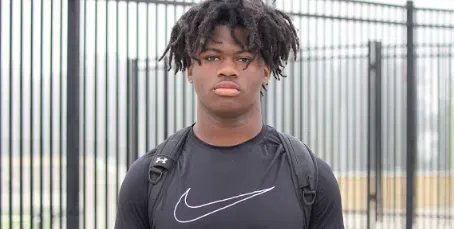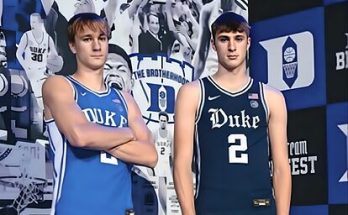In a significant development on the college football recruiting front, five-star offensive lineman Lamar Brown has officially committed to Florida State University (FSU), reversing his earlier inclination towards the University of Southern California (USC) under head coach Lincoln Riley. This decision marks a pivotal moment in Brown’s recruitment journey and has substantial implications for both programs involved.
Lamar Brown: A Profile of Excellence
Hailing from Baton Rouge, Louisiana, Lamar Brown has been a standout at University Lab High School. Standing 6-foot-4 and weighing 275 pounds, Brown has demonstrated versatility by excelling on both the offensive and defensive lines. His exceptional performance has earned him a five-star rating and the distinction of being the nation’s top interior offensive lineman in the 2026 recruiting class. Brown’s prowess on the field has attracted attention from premier college football programs nationwide.
The Initial Lean Towards USC
USC, under the leadership of head coach Lincoln Riley, has been proactive in recruiting top-tier talent to revitalize its football program. In early 2024, USC’s defensive line coach Eric Henderson extended an offer to Brown, signaling the Trojans’ intent to secure his commitment. Brown’s interactions with USC’s coaching staff, particularly with the hiring of Dre Brown, seemed to position the Trojans favorably in his recruitment. Encouraging social media exchanges and positive feedback from Brown suggested a growing affinity towards USC
The Shift in Recruitment Dynamics
Despite the initial positive indicators, the recruitment landscape began to shift as other programs intensified their efforts to attract Brown. Florida State University, under head coach Mike Norvell, emerged as a formidable contender. Norvell’s commitment to revitalizing FSU’s football program included a strategic focus on recruiting elite talent, and Brown became a central figure in this strategy. The Seminoles’ persistent engagement and the promise of a prominent role in their future plans appealed to Brown’s aspirations
The Commitment to Florida State
On February 8, 2025, Lamar Brown announced his commitment to Florida State University, a decision that reverberated throughout the college football community. This commitment not only bolsters FSU’s 2026 recruiting class but also signifies a strategic victory for Coach Norvell in securing top-tier talent from competitive recruiting landscapes. Brown’s decision underscores the effectiveness of FSU’s recruiting approach and their ability to attract elite prospects.
Implications for USC
For USC, Brown’s decision represents a notable setback, especially considering the program’s recent efforts to secure high-caliber recruits. The Trojans have faced challenges with decommitments, including those of five-star defensive linemen Justus Terry and Isaiah Gibson. Brown’s choice to commit elsewhere highlights the competitive nature of college football recruiting and the necessity for programs to adapt and respond to dynamic recruitment environments.
The Broader Recruiting Landscape
Brown’s recruitment journey exemplifies the complexities inherent in college football recruiting. Top prospects often navigate a myriad of factors, including coaching staff relationships, program prestige, development opportunities, and proximity to home. Brown’s decision-making process reflects a comprehensive evaluation of these elements, ultimately leading him to choose a program that aligns with his personal and athletic goals.
Looking Ahead
As Lamar Brown prepares to embark on his collegiate career at Florida State University, expectations are high for his impact on the field. His commitment is anticipated to enhance FSU’s offensive line and contribute to the program’s resurgence in the competitive college football landscape. For USC, this development serves as a catalyst to reassess and strengthen their recruiting strategies to secure and retain top talent in future classes.
In conclusion, Lamar Brown’s commitment to Florida State over USC underscores the dynamic and competitive nature of college football recruiting. It highlights the importance of strategic engagement, program appeal, and the multifaceted considerations that influence a recruit’s decision-making process. As programs like FSU and USC continue to vie for elite talent, the recruitment narratives of players like Brown offer valuable insights into the evolving landscape of college athletics.
The Ripple Effect on College Football Recruiting
Lamar Brown’s decision to flip from USC to Florida State is not just a major win for the Seminoles but also a reflection of the shifting power dynamics in college football recruiting. His move will have ripple effects across the recruiting landscape, influencing both future commitments and the strategies of rival programs.
Florida State’s Recruiting Momentum
FSU’s ability to secure Brown’s commitment underscores the program’s resurgence under Mike Norvell. The Seminoles have been aggressive on the recruiting trail, landing several top prospects in recent years. Brown’s commitment strengthens their offensive line, ensuring stability and dominance in the trenches for years to come.
This decision could also lead to a snowball effect, where other high-profile recruits take notice and follow suit. Top athletes often look at where elite talents are committing, and Brown’s choice to join FSU may sway other offensive linemen, skill players, and defensive stars to consider the Seminoles over competing programs.
Additionally, Brown’s move signals a shift in recruiting battles between the ACC and the Big Ten/SEC. Traditionally, powerhouses like Alabama, Georgia, and Ohio State have dominated offensive line recruiting. But with FSU landing a top-tier lineman, it shows the Seminoles can compete with the best and lure elite talent away from traditionally dominant programs.
USC’s Challenges in Retaining Top Talent
For Lincoln Riley and USC, losing Brown is a significant blow, especially after the Trojans had seemingly made strides in solidifying their recruiting class. In recent years, USC has had difficulty holding onto elite defensive and offensive linemen, raising concerns about the program’s ability to develop and retain top-tier talent.
While Riley has been highly successful in landing quarterbacks and skill position players, the trenches have been a different story. With the move to the Big Ten looming, USC must prioritize building a stronger offensive and defensive line to compete against the physicality of teams like Michigan, Ohio State, and Penn State. Brown’s decommitment raises questions about whether USC’s current approach is effective for long-term success in a more physically demanding conference.
The Trojans’ inability to retain top linemen could push the coaching staff to reevaluate their recruitment tactics. It may require investing more in NIL deals, upgrading their offensive line coaching staff, or focusing on in-state talent to build a more sustainable and stable pipeline.
How NIL and Coaching Stability Played a Role
One of the major factors in Brown’s recruitment process was the evolving landscape of Name, Image, and Likeness (NIL) opportunities. Florida State has established itself as a competitive player in the NIL space, offering attractive financial incentives for top recruits. While USC has a strong NIL program as well, reports suggest that FSU’s collective provided a more compelling package tailored to Brown’s needs.
Beyond NIL, coaching stability played a crucial role. Brown’s decision was influenced by the trust he developed with the Florida State coaching staff, particularly offensive line coach Alex Atkins. Under Atkins’ leadership, FSU’s offensive line has seen consistent improvement, producing NFL-caliber talent. In contrast, USC has undergone multiple staff changes in recent seasons, creating uncertainty about player development, particularly in the trenches.
The relationship between players and their position coaches often determines whether a recruit sticks with a commitment or flips. For Brown, the consistency and clear developmental path presented by FSU outweighed the potential appeal of playing in a high-profile offense under Lincoln Riley.
How This Impacts Future Recruiting Battles
With Brown committing to FSU, it sets the stage for even more competitive recruiting battles in the future. Several top linemen are still undecided in the 2026 class, and Brown’s move may influence their decision-making process.
For USC, this means they must now pivot quickly and try to secure alternative options at the position. The Trojans may also need to shift their focus to securing elite defensive linemen, as their current recruiting losses suggest an imbalance in the type of talent they are attracting.
For Florida State, this commitment bolsters their argument that they are a destination program for offensive linemen. If they can continue this recruiting momentum, the Seminoles could position themselves as a top-five recruiting program nationally, challenging schools like Alabama, Georgia, and Ohio State for the best talent.
Additionally, Brown’s decision might inspire other recruits who were once leaning towards USC to reconsider their options. Seeing a high-profile recruit flip could create doubt in the minds of other prospects, potentially leading to further decommitments.
Lamar Brown’s Future at Florida State
With his commitment to Florida State, Brown now has the opportunity to become a cornerstone of the Seminoles’ offensive line. As a five-star prospect, expectations will be high, and he will likely compete for early playing time.
FSU’s offensive line depth is solid, but Brown’s skill set makes him a candidate to push for a starting role as a freshman. His combination of strength, agility, and technical ability should allow him to transition seamlessly into college football.
Long-term, Brown has the potential to be an All-American and a high NFL Draft pick. If he develops as expected, he could be one of the top offensive linemen in the country by the time he is eligible for the draft. His decision to commit to FSU also ensures that he will be a key piece in the Seminoles’ push for national relevance in the coming years.



